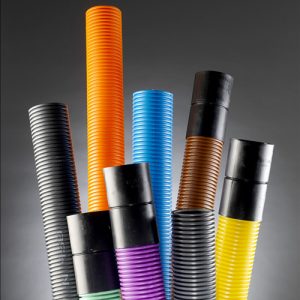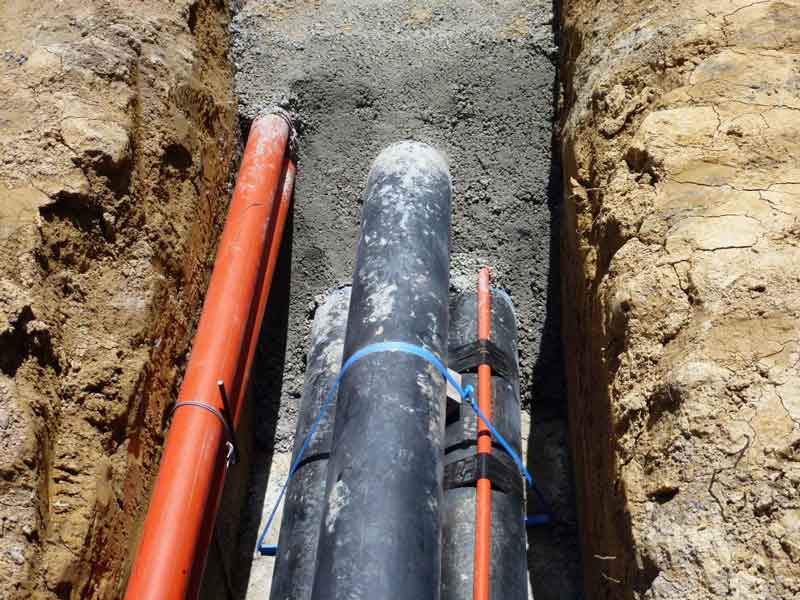Underground ducting must be colour-coded legally to comply with safety and building regulations. This is to ensure that when excavating there’s no damage to the cables as they’re housed in ducting. Ducting also serves as a warning sign as to what cables you may be accidentally interfering with so you can act accordingly. Knowing and adhering to the UK’s universal ducting cable colour codes is important.
There are minimum depth requirements for all underground utility ducting. For example, mains gas cables must be buried at least 750mm beneath a public footpath or highway. It’s worth checking minimum depth requirements with HSE or a utility provider.
Table of contents
- Underground ducting colour codes
- Why use underground ducting?
- Things to remember when installing underground ducting
- How to check your underground ducting
- What does the law say about underground cables?
Underground ducting colour codes
| Colour | Use | |
| Black | Domestic mains electric cable, low voltage | |
| Red | High voltage electric cable | |
| Yellow | Service and mains gas cable (ducting is perforated to allow for gas venting) | |
| Blue | Water pipes installed at least 750mm below surface | |
| Green | Broadband, telephone and non-motorway CCTV cables | |
| Grey | BT or telecommunications cables | |
| Purple | Motorway service cables for speed cameras, traffic cameras, emergency phones etc | |
| Orange | Street lighting and traffic signaling cables (i.e. traffic lights) | |

We offer a wide range of ducting right here at Drainage Superstore. However, if you’re still unsure, contact our super team using our helpline for advice and support.

Why use underground ducting?
Cables and pipes are a necessity. Almost every building uses utilities and services which rely on them to carry them to and from the property. Ducting is crucial when these services are buried underground. It safeguards human lives and the cables too.
Domestic and commercial buildings rely on utilities for smooth running. Services like electricity, water, gas, internet and phone lines can all be buried underground. So it’s important to protect them from the elements.
Underground cables can’t be damaged as easily
Leaving cables and pipework on the surface exposes them to all manner of issues. They can be easily broken, damaged or even purposefully tampered with. This can lead to costly repairs or replacements and poor system performance.
Pipes and cables will be subject to weathering too when left on the surface over the years. So burying them in a protective duct will slow the process.
Underground cables can’t cause damage as easily
Burying cables in cable ducting underground enhances their protection; especially electrical and gas cables. It minimises the risk to humans and animals and limits the chance that any cables will be purposefully or accidentally touched.
The ducting wrapped around the cables provides insulation from electric shocks. It also protects against other harmful events too.
Below shows street lighting and traffic cables alongside mains domestic electric cables.

Burying cables is a much neater solution than leaving them on the surface
There are millions of miles of cables in the UK. So leaving them on the surface would be practically impossible.
Burying cables is a neat solution. Especially in dense areas where perhaps 1000 new homes are built, and each home must be connected via cable to water, electric, gas, internet and communication lines at least.
Underground cables protect our water sources
Cables at both the surface and underground can leak. That’s the unfortunate truth!
Burying cables underground is a better way to ensure that any substances leaking from cables don’t immediately affect water sources. The ducting contains the leak and prevents contamination.
Things to remember when installing underground ducting
When installing underground ducting for cables, there are a few key things to remember. These will eventually become second nature to a regular installer.
Make sure you have the correct colour ducting
The colour of underground ducts isn’t just for style! Each colour represents which service or utility is in the ducting. This helps installers, excavators and anyone else know what they’re dealing with.
It’s a reliable way of protecting people, pipework and cables if it’s done correctly. So it’s wise to know the universal underground cable colour code for the UK.
For example, electric underground ducting can be black or red depending on the voltage. Learn the colour codes by viewing the table above.
Use common sense when choosing an installation area
It makes sense to first try to run ducting underground beneath a path or somewhere similar. Property boundaries could be a good idea for this, depending on the service and who owns the bordering land.
Here is an example. If the same utility company handles both plots, it doesn’t matter if the cable is buried on the boundary.
Don’t forget to use a locating device and an up-to-date plan to mark out where these cables are installed.
Double-check legal excavation depths
There is legislation that dictates the minimum burial depth for some underground cables. This is typically dependent on what the cable is and what you can reasonably expect that land to be used for for the lifespan of the cable.
Here is an example. If land could reasonably be used as farmland in the next five years, you should use farmland minimum depths.
How to check your underground ducting
Typically, you have to dig down and excavate a large portion of the soil to inspect underground ducting so before you do this why not consider any conceivable threats to the ducting?
In need of new soil for your installation? Visit our Landscaping Superstore to help you get ready for your latest gardening project!
Think about issues you already know about
Is the soil in the local area known to have chemicals in it? Is it corrosive? Was there a recent storm or a flood that could have moved or damaged the ducting?
Think back to recent events which could reasonably have caused faster corrosion or damage.
Physically inspect the ducting
After considering issues in the local area, it’s time to inspect the ducting.
Switch off the utilities and leave some time between when they were switched off to when you inspect them. You must ensure there’s no gas, electricity etc. still live in the cabling.
Avoid touching the ducting and cables
You can inspect the cables visually by assessing the condition without touching them.
Inspect them for any signs of:
- Fraying
- Obvious cracks or breakages
- Disruption in connections and;
- Any thinning of material

What does the law say about underground cables?
Street Works UK is a reliable resource for finding information about underground cables and the laws around them. This government site has six volumes of publications. Each volume contains specific information dependent on the location or use of the underground cables.
For example, Volume two offers guidelines around positioning underground utilities in new developments. Volume 3 contains information regarding the management of third-party ducting.
HSE offers more information on excavation and underground services. This includes how you should take care when digging in any area. You can also learn how to use a locating device to compare plans to what’s in the ground.
Some professionals advise you to use plans as a starting point to find underground cables and don’t take them as gospel.
Please remember: it’s illegal to use or continue to use an underground cable and any attached equipment if you know that the cabling does not comply with regulations relating to the excavation depth of underground cables and protective screens for live cables that aren’t earthed. Find more on the HSE website.


















